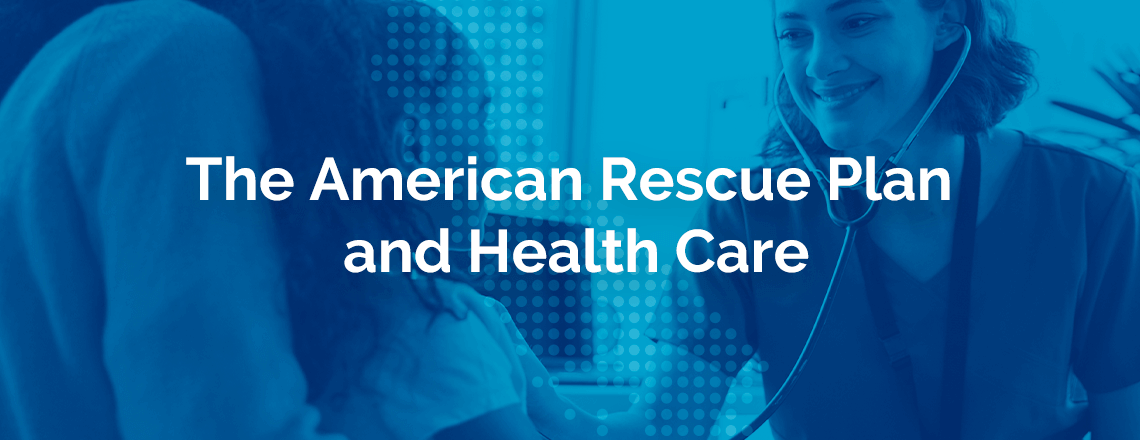The American Rescue Plan and Health Care
Posted: May 07, 2021

Millions of Americans have been hit hard by the COVID-19 pandemic, physically, emotionally and financially. According to the U.S. Department of the Treasury, over 9.5 million workers lost their jobs during the crisis, and 4 million of the unemployed have been out of work for half a year or longer.
In response to the pandemic, Congress passed the American Rescue Plan, and President Joe Biden recently signed the bill into law. The American Rescue Plan aims to bring temporary relief to individuals and businesses and help them recover from the pandemic’s economic impact. One component of the act focuses on improving access to affordable health insurance.
How does this plan affect your health care as a California resident? Let’s explore the American Rescue Plan and what it means for health insurance coverage in California.
What Is the American Rescue Plan Act of 2021?
On March 11, 2021, President Joe Biden signed the American Rescue Plan Act of 2021 (ARP). This $1.9 trillion plan provides funding for various programs, businesses, governments and institutions, including schools, child care programs and small businesses. Regarding the health care industry, the ARP includes provisions that help individuals pay for health insurance premiums. In addition, the new law gives funding to health care providers in rural regions, mental health and substance use disorder services, and programs for health care workers.
ARP Health Care Highlights for Individuals
The House first passed the ARP in February, and then it was amended and passed by the Senate and the House in March. Many of the ARP’s final health-related provisions are not different from the initial version, though we’ll cover the updates. Here are some of the ways the ARP helps individuals get the health care they need:
1. Eliminates the Subsidy Cliff
Under the Affordable Care Act, households with incomes above 400% of the federal poverty level (FPL) did not qualify for assistance with marketplace health insurance premiums. In California, households with incomes higher than 600% FPL were not eligible for subsidies. This means that households with incomes slightly above 600% FPL faced a sharp rise in health insurance premiums, known as a “subsidy cliff.”
The ARP removes the subsidy cliff and allows middle-income and higher-income households to be eligible for subsidies in the health insurance marketplace. No one needs to pay more than 8.5% of their income for a benchmark plan, meaning no household has to face extremely high premiums. A benchmark plan refers to the second-lowest-cost silver plan available in a health insurance exchange.
Consumers may choose to enroll in a plan that costs more or less than a benchmark plan. However, a household making more than 400% FPL may not receive subsidies if their insurance plan requires a contribution of less than 8.5% of their income. Likewise, if a household chooses coverage that costs more than a benchmark plan, such as a gold or platinum plan, they can pay more than 8.5% of their income.
2. Offers More Generous Subsidies
The ARP also benefits households with incomes under 400% FPL by decreasing the percentage of income a person must pay for health insurance. This new law can save households a substantial amount of money on health insurance premiums each month.
According to the Centers for Medicare and Medicaid Services, premiums will decrease an average of $85 per policy per month. Some households will not have to contribute anything towards their plan’s premium, depending on their income level. For example, many households with incomes ranging from 100% to 150% FPL can choose a premium-free benchmark plan. Overall, as a household’s income increases, their premium amount increases, but it will not go beyond 8.5%.
With more generous subsidies, more people will be able to afford health insurance through their state’s health insurance exchange or marketplace, such as Covered California.
3. Covers COBRA Premiums
If a person loses their health insurance through their employer due to a specific event, the Consolidated Omnibus Budget Reconciliation Act (COBRA) keeps them covered. COBRA continuation coverage lets people keep their health insurance under their employer’s health plan temporarily. Usually, this type of insurance is expensive, but it allows individuals to keep seeing their doctors and avoid a deductible under a new insurance plan.
To help people who have been laid off or have had their hours cut during the pandemic, the American Rescue Plan Act provides a federal subsidy of 100% of COBRA premiums. This is different from the original bill, which proposed to cover only 85% of COBRA premiums.
These subsidies are available from April 1, 2021, until September 30, 2021. During this time, you would not have to pay anything toward your COBRA premium. Instead, your employer will pay the entire premium for you and then be reimbursed by the federal government. If you have more questions, the U.S. Department of Labor put together a helpful FAQ page about COBRA premium assistance under the ARP.
4. Increases Subsidies for Individuals Receiving Unemployment Benefits
Under the ARP, people who receive unemployment compensation during 2021 face a special rule. That is, their income will be treated as if it is no higher than 133% FPL. In California, those who receive unemployment benefits and are enrolled in a Covered California plan are treated as if their income is no more than 138.1% FPL. In other words, people who receive unemployment benefits can choose a premium-free benchmark plan. The updated and final version of the act also provides maximum subsidies for out-of-pocket costs.
5. Expands Medicaid Coverage
The ARP takes several steps to improve benefits for Medicaid recipients. Under the new law, states must cover COVID-19 vaccines and treatment for eligible groups, and it expands the option for states to cover COVID-19 testing for uninsured residents. It also aims to improve health insurance for pregnant women, giving states the option to extend Medicaid postpartum coverage or coverage through the Children’s Health Insurance Program from 60 days to 12 months.

How Does a Subsidy for Health Insurance Work?
The subsidies for health insurance premiums are actually tax credits. A tax credit is a reduction in the amount of tax you owe. Even though health insurance premium subsidies are tax credits, this doesn’t mean you have to wait to get assistance until you file your taxes. Instead, you can get the subsidy in advance. This subsidy is based on your expected income for the year and paid directly to your insurance company every month by the government, which lowers your premium.
If you earn less than your estimated income, your subsidy will be incorrect and too low. You’ll get the rest of the subsidy that you should have received with your tax refund. If you make more than your estimated income, your subsidy amount will be too high. Usually, individuals have to pay back excess subsidy money when they file their taxes, known as a “clawback.” The ARP has temporarily waived this repayment requirement, and people will not have to pay this money back for 2020.
These premium tax credits are only available through a state’s health insurance exchange or marketplace. So, if you get your health insurance off the exchange, you will not be eligible for premium tax credits provided by the government.
What Does This Mean for California Residents?
The ARP will fully replace California’s state subsidies for 2021 and 2022, offering more assistance and significantly reducing the amount of money residents need to pay toward their health insurance premiums.
Thousands of Californians can benefit from the ARP’s health insurance subsidies, including insured and uninsured individuals who eventually enroll.

example, according to Covered California, the state’s health insurance marketplace, over a million enrollees with income below 400% FPL could benefit from the subsidies. The average monthly help for these households is $74. Those who are newly enrolling and are below 400% FPL can expect an average of $527 a month in subsidies.
Not sure where you fit in? Here’s an overview of what a single household is required to contribute for a benchmark silver plan under the ARP, based on income:
- $0 to $17,609: Required to contribute 0% of income
- $17,609 to $19,140: Required to contribute 0% of income
- $19,140 to $25,520: Required to contribute 0% to 2% of income
- $25,520 to $31,900: Required to contribute 2% to 4% of income
- $31,900 to $38,280: Required to contribute 4% to 6% of income
- $38,280 to $51,040: Required to contribute 6% to 8.5% of income
- $51,040 and up: Required to contribute 8.5% of income
Over a million consumers receiving unemployment benefits in the state may also get higher subsidies. Individuals receiving unemployment benefits in 2021 can pay $0 toward a benchmark plan and be eligible for the Enhanced Silver 94 plan, which offers the lowest out-of-pocket costs. They can pay $1 a month for Covered California’s Silver 94 plan for the entire calendar year of 2021. California residents who earn up to 150% FPL, which is $19,140 for a single person, are also eligible to pay $1 a month for the Silver 94 plan.
Examples of the American Rescue Plan’s Impact
To illustrate how the ARP can benefit Californians, consider these examples:
- Uninsured: Mike makes $25,520 a year, which is 200% FPL. Mike does not currently have health insurance because he thinks he can’t afford it. However, if he signs up for a benchmark silver plan in 2021, he’ll pay around $43 a month, which is about $90 less a month than what he would have paid under California’s subsidy program. These savings add up to over a thousand dollars a year.
- Off-exchange: Maria makes $60,000 a year. Since her income is over 400% FPL, she figured she wasn’t eligible for subsidies, so she bought a plan off the exchange. She’s currently paying $600 a month for coverage. If she drops her current plan and switches to Covered California, she’ll contribute 8.5% of her income toward her premium, or $425 a month — a yearly savings of $2,100.
- Insured: Ann is currently enrolled in Covered California, and she’s wondering how much her bill will be in May. Since Ann makes $38,280 a year, she’s been contributing 8.9% of her income toward her insurance premium for a benchmark silver plan. This comes to about $284 a month. Ann will pay $191 a month, or $93 less than before with the new law.
Will Covered California Refund Previous Payments?
What about any high premiums you’ve already paid? If you’ve been enrolled in a Covered California plan before May, when the new lower premiums will apply, you’ll get that money back. Covered California will calculate the new money you can get for previous coverage months and use it to lower your future monthly health insurance bills. Also, if you didn’t receive the maximum amount of new money during 2021 allowed for your income level, you may be eligible for a refund in 2022 when you file your 2021 tax return.
Can I Receive Tax Credits if My Employer Offers Insurance?
If your employer offers affordable health insurance that meets minimum value standards, you are not eligible for the ARP’s premium tax credits. Even if you turn your employer’s insurance down and enroll in a plan through Covered California, you may have to pay back all or some of the subsidies you received when you file your taxes.
Who Can Enroll in Covered California?
Anyone who is a California resident and can’t get affordable insurance through their employer can sign up for a Covered California plan.

What Happens Next?
California residents who are enrolled in a marketplace plan can expect the new subsidies to apply to their accounts beginning in May 2021 automatically. If you’re already enrolled, you can expect to see lower health insurance bills for the rest of 2021 and all of 2022 unless these changes are extended or made permanent. However, if you opted out of financial assistance when you enrolled in a plan, you’ll need to sign in to your account and update your application or report a change.
Are you uninsured or enrolled in an off-exchange plan? At Health for California Insurance Center, we can help you take advantage of the American Rescue Plan so you can get the savings owed to you.
Get a Health Insurance Quote From Health for California
If you are currently enrolled in an off-exchange plan, switching to a marketplace plan can potentially save you hundreds of dollars a month due to the ARP. If you’re currently uninsured and worried about costs, know that health insurance is now more affordable than ever before. Covered California’s new special enrollment period began on April 12 and currently runs through the end of the year, so now’s the time to claim your benefits. The sooner you enroll, the more money you can save.
At Health for California, we make it easy to enroll in a Covered California plan. To get a free quote, use our fast and simple online application or contact us for assistance.
